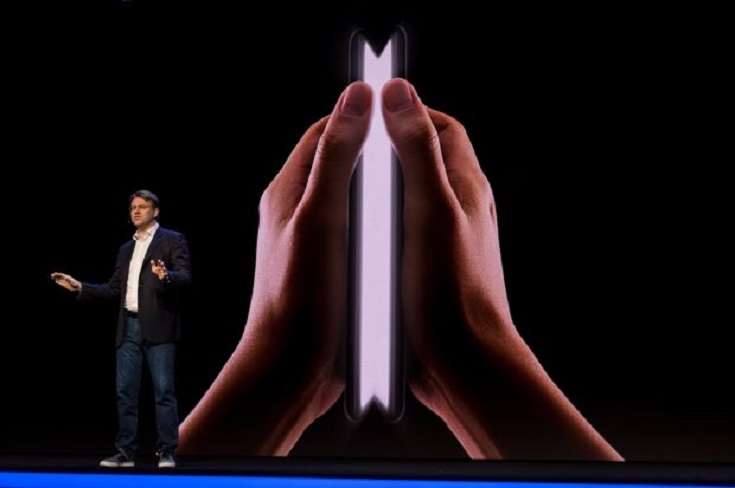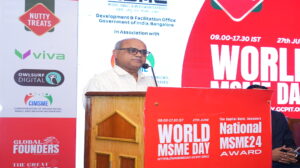Foldable phones are a chance for a tired industry: opinion

Justin Denison, senior vice president of product strategy and marketing for Samsung Electronics America Inc, speaks during the Samsung Developers Conference in California where he introduced a new phone with a foldable screen. — Bloomberg
On Wednesday, after years of rumors and speculation, Samsung finally presented a smartphone with a foldable display that it plans to start selling next year. At the risk of sounding like a wide-eyed teenager, I consider this a potentially disruptive innovation on the scale of the iPhone – if the manufacturers can handle it right.
The technology has been more or less ripe for a while: The organic light-emitting compounds and the circuitry that delivers electric charges to them can be printed onto film as well as fused into inflexible glass. But the challenges of producing a device with a flexible display have been formidable.
How does one make the folded gadget thin enough to fit into a jeans pocket and still pack a battery that can power a large screen long enough for heavy use? What kind of hinge would be needed to make sure the phone folds neatly and safely? How many times can a display be folded before it crumbles? How would apps automatically resize when a user goes from a small display to a bigger one and back again? Some of the technical problems haven’t been resolved yet – for example, Samsung apparently hasn’t found a way to embed a fingerprint reader into the foldable screen the way it’s been able to do for its next-generation glass phones.
Besides, it’s been argued, the business logic is questionable: Why would anyone want a foldable phone, anyway, and which existing technology would it disrupt? Traditional phone screens have been big enough to make tablets redundant for most people, and the tablet market – even including detachable-keyboard devices such as the Microsoft Surface and its clones – has been shrinking (unit shipments declined 5.4% year-on-year in the three months through September, according to research firm IDC). And when a startup called Royole presented a foldable-screen phone to get ahead of Samsung, a reviewer who got to play with it wrote that it felt more like a gimmick than a revolutionary device.
I’d argue that the doubts are similar to those voiced when Apple presented the original iPhone. Who wanted a touchscreen phone, anyway, and how would it compete with the enormous variety of devices out there? Of course, that alone doesn’t invalidate the doubts; plenty of technological innovations didn’t fly. Remember Amazon’s Fire Phone, which promised something akin to Star Wars holograms emerging from its display? It turned out to be a dud.
I argued at the time that Amazon was the wrong company to push an adventurous innovation like this: It didn’t have the kind of pull with developers necessary to make the new 3D functionality important to users. Samsung – and Google, which is helping the Korean giant and other phone makers bring Android to foldable devices – do have it. And there are compelling reasons both for users and for manufacturers to go with the new technology.
It’s true that smartphones with six-inch screens are killing tablets; that’s been happening ever since Samsung launched the Galaxy Note in 2011 to cries of “who would want a huge phone like this?” People, however, go for these big-screen phones as a compromise, simply because a tablet doesn’t fit into a pocket and is unwieldy for basic calling and messaging. Reading, watching videos and playing games on a big-screen phone is not particularly kind to the eyes; typing long messages on the tiny keyboards is a skill some just can’t master, at least without getting what’s now being called “smartphone thumb.” It’s all tolerable but tiring. And showing something to a friend on a six-inch screen while also trying to look at it yourself is an exercise fit for a contortionist.
For manufacturers, the benefit of pushing foldable phones could also be significant. No matter how durable the polymer of the flexible displays, it’ll wear out from a lot of folding, creating a natural (though hopefully reasonable) replacement cycle that could make it easier to plan sales and production. Now, the average upgrade cycle of a smartphone in the US is 32 months; it was 24 to 25 months in 2013 and 2014. Shortening the cycle, if only slightly, would make for a livelier smartphone market and perhaps end the current lull in unit sales (they dropped 2.1% in the three months through June).
Samsung and Google just need to play their cards right. It’s important for the former to get rave reviews with the first new product it launches and to make sure the early adopters don’t start complaining too soon about its quality; it’s necessary for the latter to tweak Android so that it’s not too much work for developers to adjust apps to foldable displays. That’s a big hurdle that should be overcome before Samsung markets anything; launching without at least the most-used apps fully compatible with the changeable form factor could kill the potential revolution in its infancy.
Everything doesn’t have to be perfect; the first iPhone wasn’t, and it only sold a million or two units per quarter in its first year. It just needs to be good enough for the early users to catch on to the advantages. It’ll only take a few years from there to mass adoption – again, barring major quality and compatibility issues. The technology will finally arrive if Apple, which buys iPhone displays from Samsung and LG (another company that has been working on flexible screens), takes the leap, as it has done repeatedly after watching other manufacturers’ experiments – bigger screen sizes, multiple camera lenses, rounded glass and other incremental innovations.
None of this is a given. I’m rooting for Samsung and Google not to mess up the opportunity. – Bloomberg






